A Design Family
Marcin Mońka: 20 years ago, the 2+3D design quarterly organised the first review of design graduation projects. Why did you create this review?
Professor Czesława Frejlich: Above all, it was our attempt to bring the design community together. Projects designed by students from various universities had never been confronted before, so we actually had no clear idea what was created in particular schools. The review was an opportunity to get to know each other and compare individual accomplishments. It also helped us acquire new readers for the quarterly, and we really cared about them. We knew they were the people who would soon define the modern era. The first eight editions of the review included Polish graduates. Then, we added the Czech Republic and Slovakia to the review. One year later, Hungary joined the selection. The venue of the review was also important. Zamek Cieszyn was keen to promote design and had the right people to do that, as well as a budget obtained from the Visegrad Fund, among others.
How has design changed over the past 20 years, taking the reviewed projects into account? Are there any striking differences between projects from the Czech Republic, Poland, Slovakia, and Hungary? Or perhaps is there a generation gap visible?
Design is influenced by a variety of factors. Intergenerational differences play an important part here, as well as new technologies. Design tools have also changed for the past 20 years. They have had a crucial impact on how projects are visualised and how products are shaped. What’s more, new industry sectors have emerged, such as web design or service design. As far as the second part of the question is concerned: yes, there are visible differences resulting from the country of origin of given projects. For instance, schools from Bratislava enjoy experimenting, whereas the Hungarians are fond of games and puzzles. Projects of this type are submitted every year from Budapest. Some universities place emphasis on the technical aspects of design, while other students focus on crafts. On the one hand, each university has its own methodology and characteristics, on the other hand – there are cultural differences to consider. However, nowadays, these differences are less distinct due to the easy access to information online.
Is there any point in submitting a project to the review these days? The review was created to give graduates an opportunity to show their works, while nowadays, in the time of social media, they have definitely more opportunities to do so than 20 years ago.
These days, presenting one’s achievements is a cheap and easy thing to do. However, we are faced with another problem: excess. It is becoming increasingly difficult to discern and evaluate information in its vastness. In the case of the review, our role as jury members is to make an honest selection based on our knowledge and experience, following hours of debate. The exhibition is another added value. It shows the selected projects – BA and MA diploma works. The networking opportunities are also invaluable: the young generations of designers get a chance to establish new contacts and build relationships. From the perspective of 20 years, I can see how many of these young designers have succeeded in the design market. Some of them still stay in touch with one another and build something like a family. This is one of the main functions of the review.
Professor Czesława Frejlich – university lecturer, member of the Graduation Projects jury, editor-in-chief of the 2+3D design quarterly, published in 2001–2016, whose editorial board came up with the idea for the Graduation Projects review.

